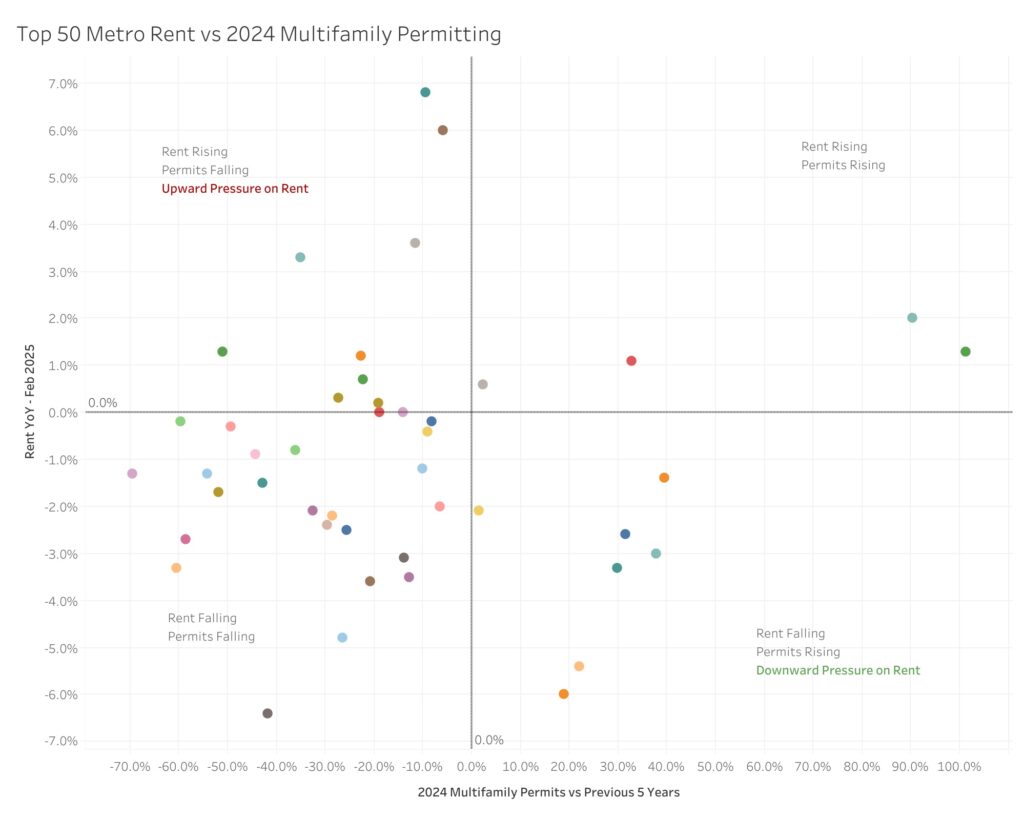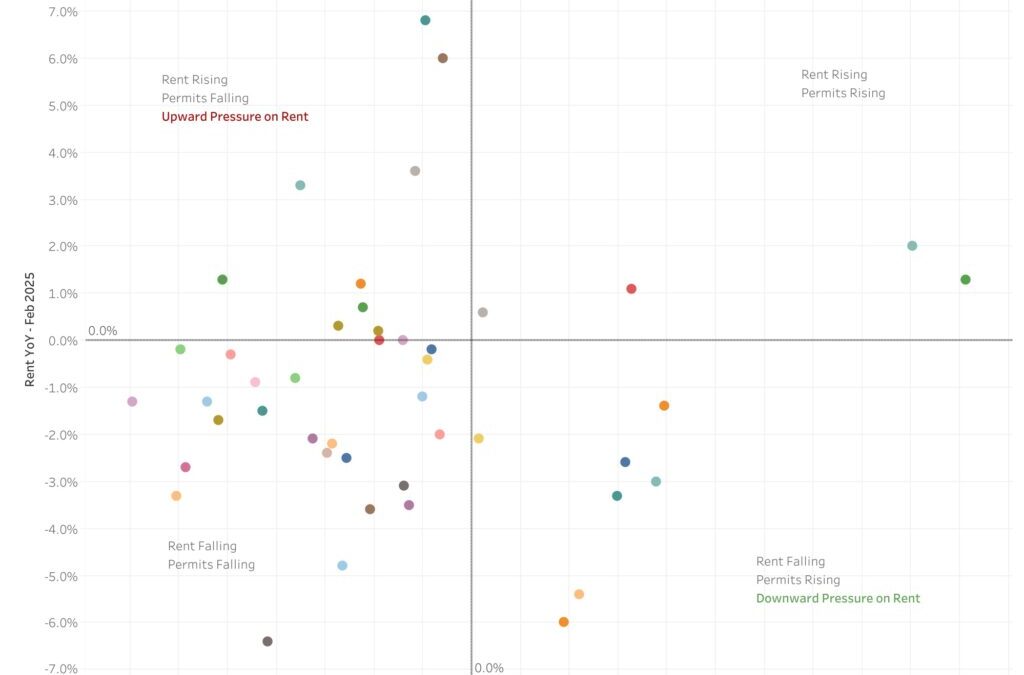Lagging Multifamily Permits Hindering Asking Rents MABA MassachusettsRealEstate FirstTimeHomeBuyers MaBuyerAgent
According to the Realtor.com February rent report, rents in the top fifty metro areas have been falling for more than a year, but low multifamily permitting activity is paving the way for rising rents. In actuality, only two hundred and ninety four thousand multifamily units were allowed in the top fifty metro areas in 2024 much fewer than the three hundred eighteen thousand units allowed during the pandemic’s peak in 2020.
“During the pandemic, rent prices surged significantly. While there has been a gradual correction, the current trend of declining rents over the past nineteen months and a still-sizable number of multi-family units under construction have impacted builders’ enthusiasm for new projects,” said Danielle Hale, Chief Economist at Realtor.com. “The nation is short 3.8 million homes according to Realtor.com research. As builders attempt to right-size their construction pipelines amid shifting economic and policy cross currents, multifamily builders nationwide have made headway, evidenced by vacancy rates trending up. Still, the shortfall varies by market and region. The low level of permitting for multifamily housing, particularly in markets where rents are still climbing, may become a catalyst for future rent growth.”

Low levels of multifamily housing permits will further constrain supply and raise the possibility of future rent increases in hot markets with high demand and rising rents. Rent increased in nine of the top fifty metro areas in 2024, including New York, Kansas City, MO; and Detroit, where multifamily permits were fewer than in recent years.
Top Ten Hot Markets Where Rent is Poised To Grow as Permits Decline
| U.S. Metro | Rent Increase YoY | Multifamily Permits vs5-year Baseline |
| New York-Newark-Jersey City, NY-NJ | 6.80 % | -9.50 % |
| Kansas City, MO-KS | 6.00 % | -6.00 % |
| Detroit-Warren-Dearborn, MI | 3.60 % | -11.60 % |
| Washington-Arlington-Alexandria, DC-VA-MD-WV | 3.30 % | -35.00 % |
| San Jose-Sunnyvale-Santa Clara, CA | 1.30 % | -51.00 % |
| Baltimore-Columbia-Towson, MD | 1.20 % | -22.60 % |
| Boston-Cambridge-Newton, MA-NH | 0.70 % | -22.30 % |
| St. Louis, MO-IL | 0.30 % | -27.30 % |
| Charlotte-Concord-Gastonia, NC-SC | 0.20 % | -19.00 % |

U.S. Rent Growth Weakens & Rises in Different Markets
However, nine of the top fifty metro areas, including Birmingham, AL, where rent decreased five point four percent year-over-year and multifamily building permits increased by twenty point ten percent from the average of the previous five years, Cincinnati, Ohio, where rent decreased three point three percent while multifamily building permits increased twenty nine point nine percent, and Cleveland, Ohio, where rent decreased three percent year-over-year and multifamily building permits increased thirty seven point nine percent from the average of the previous five years, saw more multifamily permitting in 2024 than during the previous five years. The expansion of the multifamily supply in major metro areas will further drive down rents.
Although data indicates that changes are beginning to occur in the main metro areas’ for-sale markets, where federal employment is considerable, the rental movements in these markets are still rather variable and do not yet indicate any significant changes. Rent has increased three point three percent year over year in Washington, D.C., one of the five main metro areas with the largest number of federally hired workers. Oklahoma City, has had a small increase of two percent, while Baltimore, has seen a one point twenty five percent increase. However, rent in San Diego, fell six percent from a year earlier, while it also decreased by one point five percent in Virginia Beach, VA.
The demand for larger rental apartments is still high as fewer tenants become first-time homebuyers; over the past five years, the longest-term rent rise has been eighteen point three percent for two bedroom flats. This is in contrast to studio flats, which saw the slowest increase in rent, at nine point seven percent, and one-bedroom units, which saw a fourteen point three percent increase.
Although activity in studio units is typically more volatile, this month’s rent growth for studio units decreased little at negative point eight percent YoY, more closely aligning with the negative point seven percent year-over-year declines in one and two bedroom units in February 2025.
Additionally, the fifty largest metro regions in the U.S. allowed the development of little under two hundred and ninety four thousand units in projects with five units or more in 2024. Given that rents were declining annually throughout 2024, this marks a significant retreat in multifamily development permits. Even fewer multifamily apartments were granted in the top fifty metro areas last year than during the peak of the pandemic in 2020, when more than three hundred and eighteen thousand units were approved. And now, multifamily permits fell once again and are still down fifteen point seven percent year-over-year in the Census Bureau’s most current new building data.
To read the full report, click here.
The post Lagging Multifamily Permits Hindering Asking Rents first appeared on The MortgagePoint.

FIRST TIME HOMEBUYERS
Buyer’s Agents Explained
Client Testimonial:
 "No amount of reading or web surfing can equal having a competent professional advising you and looking out for your interests. I do not understand why anyone would buy a house in MA without a MABA buyer's broker."
"No amount of reading or web surfing can equal having a competent professional advising you and looking out for your interests. I do not understand why anyone would buy a house in MA without a MABA buyer's broker."
- Samantha and Brendan, Purchased a home in Marlborough, MA 2012
Article From: "Demetria C. Lester" Read full article
Get Started with MABA
For no extra cost, let a MABA buyer agent protect your interests






